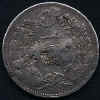The Same Chopmark found Stamped on a Japanese Dragon Yen and a Chinese Sycee
Japan Dragon Yen Dated Meiji 11th Year (1878 AD)
Chopmarks:
| Font/Font Size | ||
| 3-4 mm | > 4 mm | |
| Character | 兀 年 刀 恒 公 由 | 芳紹
德順 益 頡
上言 刊
八年 縣看 生
成 得 |
| Symbol | None | |
Collection of Lisa & Dan Malloy
* Beginning in the 3rd year of the Meiji period (1868),
Japan became one of the most active of the countries minting silver coins
intended to be used as a trading commodity in China, and made tremendous profits
from this exchange. Even after the 11th year of Meiji (1878), when Japan stopped
minting the so-called "Trade Silver", it regularly issued Dragon Yen
in large quantities. As Japan's political and military influence grew, the
Dragon Yen flooding into China commanded a larger share of the market than most
other foreign silver coins, particularly in the southern provinces of Fujien,
Kuangtung, Chekiang, Hunan, and Hubei; and the northern province of Manchuria.
* This Japan Dragon Yen dated the 11th year of Meiji bears
numerous chopmarks, all of which are at least 3 mm in diameter.
These can be attributed to the Type 2
chopmarks mainly adopted in the southern provinces such as Kuangtung and Fujien.
Some of the chopmarks are an assembly of two characters, such as
芳紹 (Fang Sao),
德順 (Der
Sung), 上言 (Shan
Yen) and ![]() (Liang
Yi), which can all be assumed to be the name of the silver shops who had handled
this silver coin.
(Liang
Yi), which can all be assumed to be the name of the silver shops who had handled
this silver coin.
* There are also two chopmarks, each comprised of two
characters, which do not looked like name of silver shop; they could, however, have been stamped by a local government. They are
八年 (the 8th year) and
縣看(checked by County). The first one most likely refers to "Kuang Hsu 8th year (1882)". The
second could be an
indication that this coin has been assayed by an official assayer of a county.
These two small chopmarks let us recreate part of the history of the circulation of this coin: 4
years after being minted in Japan in 1878, it was submitted to a local goernment
in China as a tax payment by a Chinese; at that time the local government
authenticated the coin and gave it a date chop and assaying chop.
Half Ball Sycee
Weight: 34 grams/0.9 tael
Inscription: ![]()
Collection of Lisa and Dan Malloy
* This Half Ball originated from Kueichow province and carries no dating
information, but it can be estimated to have been cast before 1909, the year the
provincial government started casting standard Half
Ball. Incidentally, it's inscription (Liang Yi), which is probably the name
of the silver shop which cast it, is the same as one of the chopmarks stamped on
the Meiji 11th year Dragon Yen. Following this clue, we can reasonably believe
that (1) this Half Ball was cast and circulated in a period between 1882-1909
(2) Chinese Silver shops were simultaneously running sycee and foreign coins
businesses; (3) Kueichow, one of the south west provinces in China, also adopted
the Type 2 chopmarks in their chopmarking practice.
Return to Chopmarked Foreign Silvers






